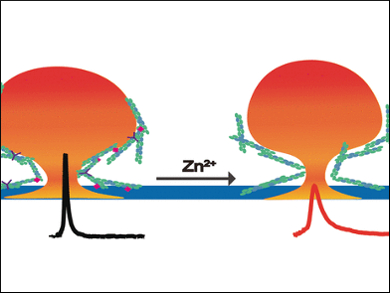Signal Transmission in Synapses
Zinc is a vital micronutrient involved in many cellular processes: In learning and memory processes, for example, it plays a role that is not yet understood. By using nanoelectrochemical measurements, Swedish researchers have made progress toward understanding by demonstrating that zinc influences the release of messenger molecules. As reported in the journal Angewandte Chemie, zinc changes the number of messenger molecules stored in vesicles and the dynamics of their release from the cell.
When signals are transmitted by synapses, messenger molecules (neurotransmitters) are released from storage chambers (synaptic vesicles) into the synaptic cleft, where they are “recognized” by neighboring nerve cells. This release is based on exocytosis: The vesicle docks at the cell membrane, opens at the point of contact, releases part of its contents to the outside, closes, and separates from the plasma membrane so it can be refilled.
Nanoelectrochemical Measurements
A team led by Andrew G. Ewing at Gothenburg University, Sweden, used carbon fiber electrodes with nanotips to study the influence of zinc on these processes. They carried out measurements on PC12 cells that release the neurotransmitter dopamine when stimulated by a high potassium concentration, analogous to nerve cells. “By applying an electrode tip to the surface of the cell, we can follow the opening of an individual vesicle and compute the number of molecules released,” says Ewing.
If the tip of the electrode is inserted into the cell, the vesicles in the cytoplasm stick to the electrode and release their full contents. Says Ewing: “The current transients allow us to determine how many transmitter molecules are contained in individual vesicles directly in the cytoplasm of the living cells.”
Zinc Regulates Chemical-Transmitter Storage
After treatment with zinc, the total number of neurotransmitters contained in vesicles was reduced, on average by 27%. However, the amount of transmitter released upon stimulation remained constant. Analysis of the current transients provided an explanation of this apparent contradiction. According to Ewing, “Zinc changes the dynamics of the release. Before and after the opening of the vesicle a pore forms at the point of contact with the plasma membrane. After treatment with zinc, the pore closes more slowly than usual. The vesicle thus stays open longer and releases 92 % of its transmitter molecules to the outside – instead of only 66 % without the zinc.”
In order to investigate this phenomenon more closely, the cells were stripped down layer by layer from the outside in and were analyzed by mass spectrometry. The researchers found one zinc species near the cell membrane and a second in the interior of the cell. “The former is capable of binding to protein kinase C, an enzyme that binds to the membrane to regulate the speed of exocytosis. The zinc species inside the cell could slow down the transport protein that loads the dopamine into the vesicles,” suggests Ewing. “Our results finally provide a connection between zinc and the regulation of neurotransmitter release. This could be important for the formation and storage of memories.”
- Zinc Regulates Chemical-Transmitter Storage in Nanometer Vesicles and Exocytosis Dynamics as Measured by Amperometry,
Lin Ren, Masoumeh Dowlatshahi Pour, Soodabeh Majdi, Xianchan Li, Per Malmberg, Andrew G. Ewing,
Angew. Chem. Int. Ed. 2017.
DOI: 10.1002/anie.201700095
